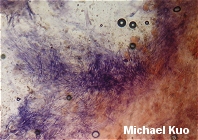| Major Groups > Gilled Mushrooms > Dark-Spored > Chroogomphus |

|
The Genus Chroogomphus [ Basidiomycetes > Boletales > Gomphidiaceae . . . ] by Michael Kuo This small genus of gilled mushrooms is actually more closely related to the boletes than to the "true" gilled mushrooms. Like species of Phylloporus and Gomphidius (among others), the mushrooms in Chroogomphus appear to have developed their gills independently, on the bolete branch of the evolutionary tree, according to genetic evidence. Sometimes referred to as "pine spikes," the mushrooms in Chroogomphus are mycorrhizal partners with conifers, recognized by their blackish spore prints, their gills (which are attached to the stem or, more commonly, begin to run down it), and the orangish to yellowish or reddish color of the flesh in the cap. They can be distinguished from species of Paxillus by the fact that the gills are not separable in a layer (see the page for Paxillus vernalis for an illustration), and from species of Phylloporus by the fact that the gills are not thick, waxy, and yellow. Additionally, the spore print is not blackish in either Paxillus or Phylloporus. The more difficult distinction is between Chroogomphus and Gomphidius. Absent a microscope, the differences include the sliminess of the cap (more so in Gomphidius) and the orange-yellow-reddish flesh; species of Gomphidius are white-fleshed in the cap when young, though they frequently develop yellow colors on the stem, particularly at the base. The matter is quickly resolved with microscopic analysis, however, since species of Chroogomphus have cells that turn purple in Melzer's Reagent (see the illustration), while species of Gomphidius do not. |
© MushroomExpert.Com |
|
Identifying Chroogomphus species ranges from fairly easy to fairly difficult, requiring microscopic analysis. The late Orson Miller published treatments of the genus throughout his esteemed career, and in recent years he was able to begin redefining species on the basis of preliminary DNA evidence (2003, 2006). One recent development of particular interest is Miller's discovery that "Chroogomphus rutilus" does not occur in North America; see the explanation on the page for Chroogomphus ochraceus. Key to 9 Chroogomphus Taxa in North America
*Despite attempts by several authors to delineate differences (or trends) in cap color between Chroogomphus vinicolor and Chroogomphus ochraceus/rutilus, the thickness of cystidial walls is a more reliable indicator, and "[t]here is no evidence . . . that the pileus coloration is an important character at the species level" (Miller, 2003). References Kauffman, C. H. (1925). The genus Gomphidius in the United States. Mycologia 17: 113–126. Li, Y. C., Z. L. Yang & B. Tolgor (2009). Phylogenetic and biogeographic relationships of Chroogomphus species as inferred from molecular and morphological data. Fungal Diversity 38: 85–104. Martín, M. P., J. Ll. Siquer, J. C. Salom, M. T. Telleria & G. Finschow (2016). Barcoding sequences clearly separate Chroogomphus mediterraneus (Gomphidiaceae, Boletales) from C. rutilus, and allied species. Mycoscience 57: 384–392. Miller, O. K. Jr. (1964). Monograph of Chroogomphus (Gomphidiaceae). Mycologia 56: 526–549. Miller, O. K. Jr. (1966). A new western species of Chroogomphus. Mycologia 58: 855–861. Miller, O. K. Jr. & J. M. Trappe (1970). A new Chroogomphus with a loculate hymenium and a revised key to section Floccigomphus. Mycologia 62: 831–836. Miller, O. K. Jr. et al. (2002). Two new species of Gomphidius from the western United States and eastern Siberia. Mycologia 94: 1044–1050. Miller, O. K. Jr. (2003). The Gomphidiaceae revisited: a worldwide perspective. Mycologia 95: 176–183. Saitta, S., M. Bianchi & M. Carbone (2020). Tre specie di Chroogomphus interessanti in Italia. Rivista di Micologia 63: 75–93. Scambler, R., T. Niskanen, B. Assyov, A. M. Ainsworth, J. -M. Bellanger, M. Loizides, P. -A. Moreau, P. M. Kirk & K. Liimatainen (2018). Diversity of Chroogomphus (Gomphidiaceae. Boletales) in Europe, and typification of C. rutilus. IMA Fungus 9: 271–290. Singer, R. (1949). The genus Gomphidius Fries in North America. Mycologia 41: 462–489. Thiers, H. D. (1985). The Agaricales of California. 3. Gomphidiaceae. Eureka, CA: Mad River Press. 20 pp. This site contains no information about the edibility or toxicity of mushrooms. Cite this page as: Kuo, M. (2007, October). The genus Chroogomphus. Retrieved from the MushroomExpert.Com Web site: http://www.mushroomexpert.com/chroogomphus.html |

